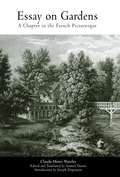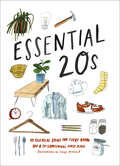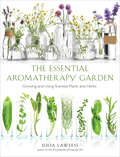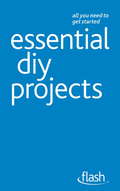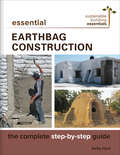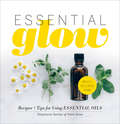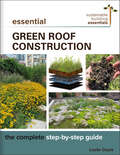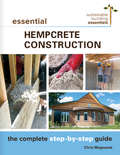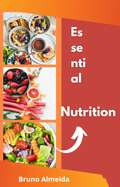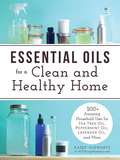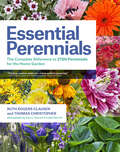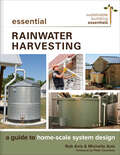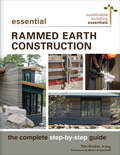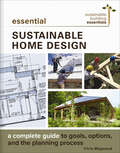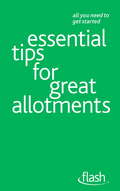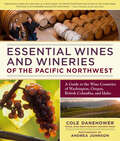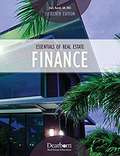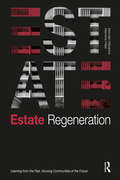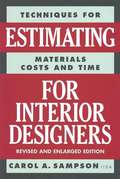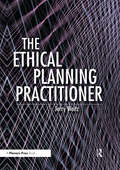- Table View
- List View
Essay on Gardens
by Joseph Disponzio Samuel Danon Claude-Henri WateletPublished in 1774, Essay on Gardens is one of the earliest texts showing the progressive shift in French taste from the classical model of the gardens at Versailles to the picturesque or natural style of garden design in the late eighteenth century. In this formulation of his ideas concerning landscape, Claude-Henri Watelet describes an ideal farm and also his own very real garden, Moulin Joli, near Paris. He advances the theory that the useful and the pleasurable must be combined in the planning, preservation, and decoration of the land by offering a relatively novel design that uses experimental methods to create a comfortable estate. The result is a horticultural and ecological laboratory that includes a residence, a farm, stables, a dairy, an apiary, a mill, walks, vistas, flower beds, an area reserved for medicinal plants, decorative statues, a medical laboratory, and even a small infirmary for ailing members of the community.Given the wide scholarly interest in the field of garden design and its history, this first English edition of Watelet's small but influential book will interest historians of landscape design as well as students of the history of architecture. Joseph Disponzio's informative introduction to Samuel Danon's masterful translation situates the Essay on Gardens within the framework of other landscape and garden treatises of the late eighteenth century. Although the original text was not illustrated, this edition includes a selection of charming drawings and etchings of Moulin Joli by Watelet himself, Hubert Robert, and others.
Essential 20s: 20 Essential Items for Every Room in a 20-Something's First Place
by Lizzy StewartA fun illustrated guide to the things you need for your new place!Getting your first place is a major milestone—now you just need the stuff that goes inside it. This visual catalog reminds you of the things you’ll want to put on your list (including a few you might have forgotten). Find pictures of the essentials:Bedroom * Bathroom * Pantry and refrigerator * Clothes closets * Medicine chest * Toolbox * Technology * Travel gear * Living room * Dining room * Kitchen cabinets * and more
Essential Aromatherapy Garden: Growing and Using Scented Plants and Herbs
by Julia LawlessThe ultimate illustrated guide to growing an aromatherapy garden and using essential herbs and oils for healing and inspiration <P><P>This is a life-style book that will appeal to those who use essential oils and herbs for their healing properties and those looking for inspiration and practical tips for creating and cultivating aromatherapy gardens. It is a gift/wish book and an appealing introduction to the aromatherapy garden--both past and present. <P><P>There are 7 sections in this lavishly illustrated book: <P><P>History of the Scented Garden <P><P>Aromatic Herbs for Health and Cooking <P><P>Creating a Perfumery and Aromatherapy <P><P>Fragrant Exotica and Container Plants <P><P>Secrets from the Still Room <P><P>Planning an Aromatherapy Garden <P><P>Aromatherapy Plant Portraits <P><P>This is the essential home reference book on herbs and oils. It will be embraced by home healers, aromatherapists, and gardening fans alike.
Essential Building Science: Understanding Energy and Moisture in High Performance House Design (Sustainable Building Essentials)
by Jacob Deva RacusinDown and dirty – a complete step-by-step guide to making, installing and living with beautiful, all-natural earthen floors Poor heat and moisture management are the enemies of durable, comfortable, and efficient housing, and good building design and construction starts with a solid understanding of good building science. Essential Building Science provides a highly visual and accessible introduction to the fundamentals of building science for residential construction.Part one covers the rationale behind high-performance design and the fundamentals of building physics, including thermal dynamics, moisture transfer, and hygro-thermal dynamics such as vapor drive and condensation.Part two teaches the vital critical thinking skills needed to consider buildings as whole systems and to develop thermal and moisture control strategies regardless of the specifics of the design. Case studies and examples from across North American climatic zones illuminate real-life problems and offer builders, designers, and DIYers the insights and tools required for creating better new buildings and dramatically improving old ones.Good science plus critical thinking equals high performance buildings.
Essential DIY Projects: Flash
by Diy DoctorThe books in this bite-sized new series contain no complicated techniques or tricky materials, making them ideal for the busy, the time-pressured or the merely curious. Essential DIY Projects is a short, simple and to-the-point guide to that will teach you a number of essential projects around the house in just 96 pages. Suitable even for those who've never picked up a hammer, this is an ideal starting point for the new home-owner or tentative DIY-er.
Essential Earthbag Construction: The Complete Step-by-Step Guide (Sustainable Building Essentials)
by Kelly Hart&“A must-have book for anyone interested in natural and sustainable building. It expands the possibilities with practical and essential information.&” —Will Beemer, Director of the Heartwood School for the Homebuilding Crafts and author of Learn to Timber Frame. Build economical and resilient earthbag structures using simple tools and techniques. Earthbag construction—building with polypropylene bags usually filled with earthen materials—is a versatile, easy-to-master, low-impact, and highly durable form of building, suitable for structures from houses to root cellars. Containing over seventy-five photos and illustrations, Essential Earthbag Construction is a practical guide to this affordable method of building. Going well beyond the scope of other sources, this indispensable manual is packed with all the information you need to determine if it&’s the right choice for your project, and to start building. Distilling decades of experience, research, and best practices, it covers: Material specifications, performance, and when and where to use it Pros and cons of different fills from gravel, to earth and clay, to insulative perlite, rice hulls, and volcanic stone Illustrated, step-by-step guidance for efficient bag filling and installation Details for various designs, including domes and arches Foundation options and seismic and stability considerations Finishing and maintenance techniques Tools and materials Additional resources. Essential Earthbag Construction presents the practical guidance and best practices for both the DIYer and professional to design and build high-quality earthbag structures. &“A comprehensive, practical and inspirational guide that is both detailed and easy to follow.&” —Jenny Pickerill, Professor of Environmental Geography, University of Sheffield, UK and author of Eco-Homes: People, Place and Politics &“Everything you need to know for success.&” —Michael G. Smith, co-editor, The Art of Natural Building and co-author, The Hand-Sculpted House
Essential Glow: Recipes & Tips for Using Essential Oils
by Stephanie GerberDiscover how essential oils can boost your beauty, home, and wellness with over 200 easy recipes and projects from the author of Hello Glow. Lavender, chamomile, tea tree, rose, and sandalwood—invite the aromatic and healing powers of your favorite herbs and botanicals into your life with this beautiful guide. You&’ll discover recipes, quick tips, and DIY projects to boost your beauty, home, and general wellness with your favorite essential oils, plus a diagnostic tool that helps you treat common ailments with the right essential oils. We&’ve all heard that essential oils are good for us—the aromas and chemicals in these special distilled herbal treatments can soothe the senses, kick-start a sluggish day, or even help restore health or repair troubled skin. There are a whole host of ways to use them—from decadent massage candles to hardworking laundry softeners, from relieving bug-bite balm to skin-clearing concoctions. Essential Glow is packed with everything the aromatherapy DIY-er needs: 200+ recipes and projects with simple step-by-step instructions, targeted aromatherapy blends, a pantry primer, and much more.Featured essential oils include:Soothe: Lavender, Roman Chamomile, Geranium, Rose, Clary Sage, Jasmine, Ylang Ylang, SandalwoodUplift: Peppermint, Sweet Orange, Cinnamon, Atlas Cedarwood, Lemongrass, Juniper Berry, RosemaryRestore: Oregano, Frankincense, Ginger, Tea Tree, Lemon, Eucalyptus
Essential Green Roof Construction: The Complete Step-by-Step Guide (Sustainable Building Essentials)
by Leslie DoyleFor the do it yourself builder, an “essential guide . . . to install and maintain a beautiful and ecological compliment to your home or office” (Kelly Hart, author of Essential Earthbag Construction).Essential Green Roof Construction is a comprehensive, in-depth guide to building simple green roofs for houses and small buildings.Packed with detailed photos, illustrations, case studies, and code compliance advice, it offers clear step-by-step instructions necessary to create your own living roof on a new build or as a retrofit. This book includes:The benefits of a green roofThe basics of planning and designAssessing site conditions such as aspect, slope, and loadsNavigating building codes and working with building officialsMaterial options, including professional grade and economical or local alternativesPlanting suggestions for different roof climates and conditions, including food productionWhen to call on professionals to ensure safety and integrityStep-by-step guidance for safe roof installation and detailingAnnual green roof maintenance.Where common sense meets beauty—a green roof is a system of layers that work together to support plant life, insulate homes, and make the world a greener place.Essential Green Roof Construction will give you the knowledge and confidence to install your own green roof.“Impressive . . . and, importantly, easy for the average person to understand.” —Stephen Hill, associate professor, School of the Environment, Trent University“Well-written, well-researched, and full of clear and informative drawings and photos.” —Lloyd Kahn, editor-in-chief, Shelter Publications, author, Shelter and The Half-Acre Homestead“An excellent resource for both DIY and design professionals.” —Tim Krahn, P. Eng. Building Alternatives Inc., author, Essential Rammed Earth Construction
Essential Hempcrete Construction: The Complete Step-by-Step Guide
by Chris MagwoodHempcrete is a versatile, energy-efficient natural insulation material, useful for walls, roofs, and floors. Made from the inner stem of the hemp plant mixed with a lime-based binder, it is a very strong, lightweight and breathable alternative to manufactured insulations. Essential Hempcrete Construction is a fully-illustrated practical guide to this affordable, renewable method, from procurement to finishing.This indispensable manual is packed with all the information you need to determine whether hempcrete is the right choice for your project. It covers: Material specifications, testing and building code references and climate data Detail drawings for design reference Tool lists, and complete step-by-step instructions for mixing and placing hempcrete Finishing and maintenance techniques Budgeting and labor estimates Additional resourcesEssential Hempcrete Construction is part of New Society's Sustainable Building Essentials Series. Written by the world's leading sustainable builders, designers and engineers, these succinct, user-friendly handbooks are indispensable tools for any project where accurate and reliable information are key to success. Get the Essentials!Chris Magwood is a sustainable builder and designer specializing in green and natural building techniques, the co-founder and co-director of the Endeavour Centre, and the author of several books on sustainable building including Making Better Buildings, More Straw Bale Building, and Straw Bale Details.
Essential Nutrition (Health Series #1)
by Bruno AlmeidaThe writer has tried to be as accurate and complete as possible in the creation of this report, but he does not guarantee the content described due to the rapid changes on the internet. Although every attempt has been made to verify all information in this publication, the publisher assumes no responsibility for errors, omissions, or misinterpretations of this book. Any references to specific people, organizations are not intentional. In practical advice books, as in life, there are no guarantees for an outcome. Readers are warned to make their own judgment about their circumstances and act accordingly. This book is not intended to be used as legal counsel. All readers are advised to seek the services of competent professionals in the legal fields.
Essential Oil Pocket Reference, third edition
by Essential Science PublishingReference on Essential oils and their use and profiles.
Essential Oils Desk Reference (4th edition)
by The Editors at Essential Science PublishingAn extraordinary, definitive work on the therapeutic value of essential oils, including their background, chemistry, safety; single oils; blends and massage oils; supplements and hormone therapy; personal care; animal care; VitaFlex, Raindrop and Auuricular; cleansing and dietary programs; and personal usage reference.
Essential Oils for a Clean and Healthy Home: 200+ Amazing Household Uses for Tea Tree Oil, Peppermint Oil, Lavender Oil, and More
by Kasey SchwartzAs seen on Today.com Discover the power of essential oils!From tea tree and lavender to lemon and peppermint, essential oils have been praised for their ability to clean and protect surfaces. Essential Oils for a Clean and Healthy Home teaches you how to use all-natural oils around your home, from cleaning kitchen appliances to disinfecting bathrooms to getting rid of pests and smells. Featuring step-by-step instructions and plenty of helpful tips, this book offers 250 essential oil recipes that help:Eliminate stains and smells from spills, smoke, pets, and moreNaturally repel mice, spiders, ticks, fleas, lice, and flying insectsClean and maintain a variety of surfaces from wood to leather to graniteSafely disinfect toys and play areasThere's really nothing essential oils can't handle--from repelling ants, to removing rust stains, to eliminating smells in washing machines--and all without the need for dangerous chemicals. With Essential Oils for a Clean and Healthy Home, you'll discover all the benefits that a few drops of essential oil can bring.
Essential Perennials: The Complete Reference to 2700 Perennials for the Home Garden
by Alan L. Detrick Thomas Christopher Ruth Rogers ClausenEssential Perennials focuses on what every gardener needs to know to choose from the thousands of perennials available, and care for the ones you already have. This A-to-Z guide is packed with more than 2,700 plants, with each entry listing flower color, bloom time, foliage characteristics, size, and light and temperature requirements. Each profile is supported by stunning color photography that showcases the flower and foliage that make each plant unique.
Essential Rainwater Harvesting: A Guide to Home-Scale System Design (Sustainable Building Essentials)
by Rob Avis Michelle Avis&“You owe it to your family to follow the prescriptions in this book and be prepared for droughts and shortages through rainwater harvesting.&” —Jerry Yudelson, author of Dry Run: Preventing the Next Urban Water Crisis Water is a crucial resource increasingly under stress. Yet rainfall, even in arid climates, can make up a sizable portion of any home, acreage, or farm&’s water requirements if harvested and utilized with care. The key is appropriate planning and high-quality site- and climate-specific design.Essential Rainwater Harvesting is a comprehensive manual for designing, building, and maintaining water harvesting systems for the warm and cold climates of the world. Presenting design considerations and approaches for the most common household rainwater supply scenarios—primary, supplemental, and off-grid supply—this step-by-step approach covers: Considerations for full-property water security Demand planning and conservation strategies Supply calculations and design implications for extreme rainfall and drought Materials selection and water quality System and site assessment Sizing and design of gutters, conveyance, tanks, and pumps Pre-filtration, filtration, and disinfection options System maintenance and upkeep This practical resource provides DIYers, trades, and rainwater practitioners with the essential tools, methods, and technical know-how to design, build, and maintain rainwater harvesting systems anywhere. &“Go to it! Become a rainwater harvester! Embrace your downpipes and filtration systems! And all the while with this brilliant book stuffed into your back pocket.&” —Rob Hopkins, founder of the Transition movement &“Inspired to save your own rainwater for garden and home? Essential Rainwater Harvesting is bursting with personal, practical, and precise information to get gardeners saving water right now.&” —Donna Balzer, author of No Guff Vegetable Gardening
Essential Rammed Earth Construction: The Complete Step-by-Step Guide (Sustainable Building Essentials)
by Tim Krahn&“All of the essential knowledge for completing a successful rammed earth project. Written by a geo-technical engineer with experience ramming earth.&” —Kelly Hart, author, Essential Earthbag Construction Everything you need to know to build with rammed earth in warm and cold climates. Rammed earth—sand, gravel, and clay or lime/cement binder packed into forms—is a low-energy, high-performance building method, yielding beautiful, sustainable results. It&’s thermally stable and can be insulated, can actively modulate humidity, provides a healthy indoor environment, and allows site materials to be used for major structural and building envelope elements.Essential Rammed Earth Construction covers design, building science, tools, and step-by-step building methods for any climate, with a special emphasis on building in cold climates of the northern US, Canada, and northern Europe. Coverage includes: Overview of earthen building Appropriate use of rammed earth walls Stabilized versus raw rammed earth Design considerations, including structural, insulation, and building envelope details Special considerations for cold and freeze-thaw climates Construction drawings, with step-by-step building instructions Tools and labor covering industrial methods, low-tech techniques, formwork options, mix design, budgets, and schedules Codes, inspections, and permits. This guide is an essential resource for experienced builders, DIY home owners, designers, engineers, and architects. &“A much-needed and science-based update to a North American audience of designers, engineers and builders.&” —Bruce King. P.E., author, The New Carbon Architecture &“ A great book for anyone who wants to deepen their technical knowledge of rammed earth walls systems. It&’s very helpful to have a book on rammed earth that is more focused on engineered rammed earth walls for cold climates.&” —Clifton Schooley, Clifton Schooley & Associates, Rammed Earth Designers and Builders
Essential Sustainable Home Design: A Complete Guide to Goals, Options, and the Planning Process (Sustainable Building Essentials)
by Chris MagwoodDesign your own sustainable home Many people dream of building a beautiful, environmentally friendly home. But until now there has been no systematic guide to help potential builders work through the complete process of imagining, planning, designing, and building their ideal, sustainable home. Essential Sustainable Home Design walks potential homebuilders through the process starting with key concepts, principles, and a project vision that will guide the house to completion.Coverage includes:How to clarify your ideas and create a practical pathway to achieving your dreamA criteria matrix to guide design, material, and systems decisionsCreating a strong, integrated design team and working with professionals and code officials to keep the project on track from start to finish.Key building science concepts that make for a high-performance, durable buildingPrimer on building logistics, material sourcing, and protocols to ensure that the initial vision for the project comes to fruition.One-page summaries and ratings of popular sustainable building materials and system options.Ideal for owner-builders and sustainable building contractors working with clients aiming to design and build a sustainable home. Chris Magwood has designed and built some of the most innovative, sustainable buildings in North America, including the first off-grid, straw bale home in Ontario. He is co-founder and director the Endeavour Centre for Innovative Building and Living and co-editor of the Sustainable Building Essentials series. Chris is the author of Essential Prefab Straw Bale Construction, Essential Hempcrete Construction, Straw Bale Details, More Straw Bale Building , and Making Better Buildings .
Essential Tips for Great Allotments: Flash
by Geoff StokesThe books in this bite-sized new series contain no complicated techniques or tricky materials, making them ideal for the busy, the time-pressured or the merely curious. Essential Tips for Great Allotments: Flash is a short, simple and to-the-point guide that will teach you all the fundamentals for your allotment, from what tools to use to which crops to grow in just 96 pages. For those new to allotments, this is an ideal starting point for growing your own produce organically.
Essential Wines and Wineries of the Pacific Northwest: A Guide to the Wine Countries of Washington, Oregon, British Columbia, and Idaho
by Andrea Johnson Cole DanehowerSuperbly balanced pinot noirs; crisp rieslings; rich, heady syrahs: these are only a fraction of the expertly crafted wines being produced in the Pacific Northwest's diverse and distinctive wine countries. Second only to California in production, the Pacific Northwest is the largest wine region in North America, home to more than 1,000 wineries. What was once a young wine-growing area with a reputation for eccentricity is today recognized as a dynamic region producing world-class wines, with a focus on ecologically sound practices.This definitive volume profiles the wines, the people who make them, and the wine countries of Washington, Oregon, British Columbia, and Idaho. The journey begins with the region's climates and geology, which create a fascinating tapestry of wine-growing areas. Next, the book focuses on the unique qualities of each wine region, with profiles of more than 160 representative wineries to visit. Included are legacy wineries that helped to build the region’s reputation, prestige wineries with a national presence, under-the-radar artisan wineries that embody the pioneering spirit of the Northwest, and promising new wineries. Each profile lists the winery's signature, premium, value, and estate wines.Beautifully illustrated with photographs and helpful maps, this in-depth guide is a milestone in the North American literature on wine. It will enable wine lovers everywhere to plan their touring, select their wines, and explore and discover the riches of the Northwest's wine country.
Essentials of Real Estate Finance
by Doris BarrellThis dynamic textbook combines solid concepts of real estate finance, but it also gives you a solid foundation for a career in real estate. In this course, you will learn about monetary systems, primary and secondary money markets, and sources of mortgage loans. You will also learn about federal government programs, loan applications, processes and procedures, closing costs, alternative financial instruments, Equal Credit Opportunity Act, Community Reinvestment Act, and the state housing agency.
Estate Regeneration: Learning from the Past, Housing Communities of the Future
by Brendan Kilpatrick Manisha PatelOne hundred years ago, the Addison Act created the circumstances for the large scale construction of municipal housing in the UK. This would lead to the most prolific phases of housing estate building the country has ever seen. The legacy of this historic period has been tackled for the last twenty-five years as these estates began to suffer from misguided allocation policies, systemic building and fabric failure and financial austerity. A series of estate regeneration programmes sought to rectify the mistakes of the past. Estate Regeneration describes 24 of these regeneration schemes from across the UK and the design philosophy and resident engagement which formed each new community. A number of essays from a wide range of industry experts amplify the learning experience from some key estate regeneration initiatives and provide observations on the broader issues of this sector of the housing market. Regeneration is inevitable; it is a matter of the form which regeneration should take. The information presented here is a guide to an intuitive approach to estate regeneration which commences with the derivation of strong urban design principles and is guided by real community engagement. The experience presented seeks to learn from the mistakes of the past to create the best possible platform for regeneration of the housing estates of the future.
Estimating for Interior Designers
by Carol A. SampsonThis completely updated and revised edition provides all the basic, nuts-and-bolts information readers expect, along with all-new sections on faux finishing, including trompe l'oeil; Roman shades; and using upholstery fabrics for drapery and bed coverings.
Ethical Planning Practitioner
by Jerry WeitzIf a local college gives a city planner tickets to a sold-out football game, is it wrong to take them – even if the planner pays? Should a planning consultant bid on a project that has a clearly unrealistic timeframe? Can a planning director moonlight for another agency? For practicing planners, potential ethics violations abound, and the eye of public scrutiny never blinks. Planners need a guide, and now they have it: the first guidebook based on the current revision of the AICP (American Institute of Certified Planners) Code of Ethics and Professional Conduct. The Ethical Planning Practitioner presents 76 scenarios, all real-life dilemmas based on the code's rules of conduct. Each scenario comes with tools to help planners explore the answers on their own, in a training session, or in a classroom. This vital handbook looks at everyday ethics the way planners need to see them, in black, white, and shades of gray – but most of all, clearly. It will not only instruct but inspire planners to strengthen the public's trust.
